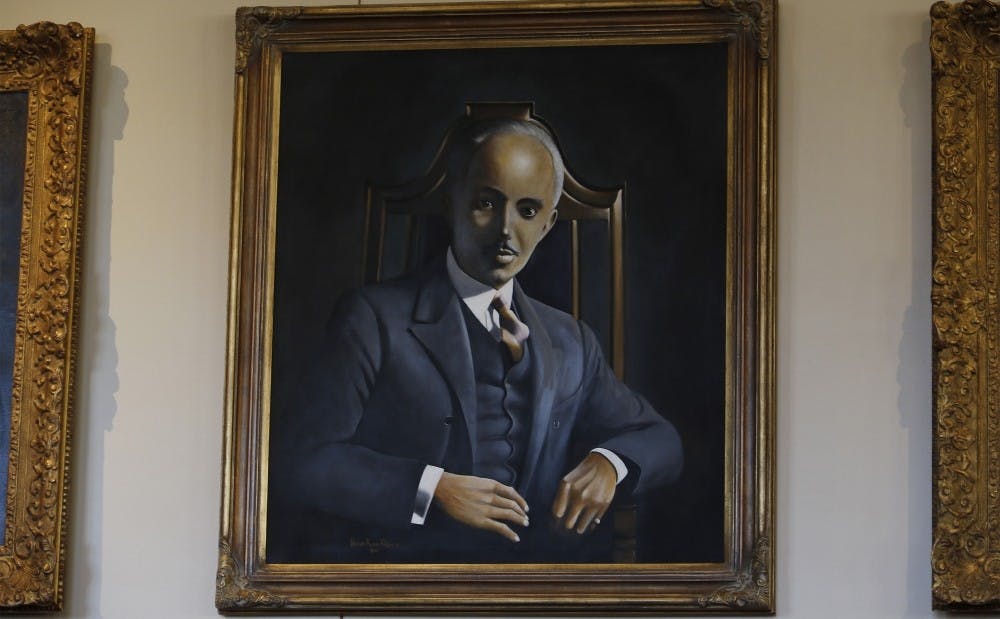President Richard Brodhead announced Tuesday that the main quadrangle on West Campus will be named after Julian Abele, the black architect of Duke's original campus.
In a community forum in November, titled “Duke Tomorrow: Student-Organized Discussion with Brodhead and Administration,” students presented Brodhead, Provost Sally Kornbluth and Valerie Ashby, dean of the Trinity College of Arts and Sciences, with the “Demands of Black Voices”—which included a point that Abele be recognized. In December, Brodhead announced an advisory group, chaired by Executive Vice President Tallman Trask, to consider how to honor Abele’s legacy. The group was scheduled to report to the Board of Trustees at its February 2016 meeting, which occurred Saturday at the Washington Duke Inn and Golf Club. During the meeting, the trustees unanimously voted to approve the
“The recognition of Julian Abele will henceforward be woven deep into the experience of Duke,” Brodhead wrote in an email to the Duke community Tuesday.
One of said demands was to name the new West Union “Abele Union” and to erect a statue in Abele’s honor
In June 2014, when Aycock dorm was renamed East Residence Hall, the Trustees turned down the possibility of renaming the dorm after Abele because the architecture was not of sufficient quality to honor his legacy.
Abele Quad will span the area from the steps leading to Clocktower Quad, Davison Quad and the Chapel Quad—an area home to more than 30 different buildings or spaces Abele designed, according to a Duke Today release. A marker naming the quadrangle will also be placed at the center to “inform viewers that every building they now see is the work of Abele’s hand,” Brodhead wrote.
Matthew Bunyi, a graduate student in the Sanford School of Public Policy, praised the move as recognizing minorities who played an integral role in the University’s development. He noted, however, that the demand for a statue was not met, adding that he would like to see students fundraise to get the construction of one underway.
Sophomore Chris Cook, the great-great-grand nephew of Abele, agreed that Brodhead’s announcement was an “excellent way of honoring him” and “very generous.”
A plaque honoring Abele will also be placed in the Duke Chapel, the release said. The University will purchase the rights to the “Shadow and Light” mural, dedicated to Abele by black artist Odili Odita, and make it a permanent fixture in the Nasher Museum of Art. The mural is already displayed in the Nasher, but was previously scheduled to be removed in three years.
Lastly, the University will create a biography of Abele and fund the Julian Abele Awards and Recognition Banquet, which honors the achievements of black community members. The awards were first hosted in 1990 by the Black Graduate and Professional Student Association and are now co-sponsored by the Black Student Alliance and the Mary Lou Williams Center for Black Culture, according to the Duke Student Affairs website.
In 1906, Abele was hired as an architect for the firm of American
"One of the most astonishing facts of Duke history is that during the darkest days of racial segregation, an African American designed the campus of the new Duke University," Brodhead wrote.
Brodhead noted in his email, however, that Abele’s role remained largely invisible to the Duke community at the time, and only became widely known in the late 1980s. In 1986, Susan Cook, Abele’s great-grand niece, wrote a letter to The Chronicle noting that Abele had designed many West Campus buildings. In 1988, a portrait of Abele was hung in the lobby of the Allen Building, which was also Abele’s last creation prior to his death in 1950.
The advisory group included students, faculty, alumni and Durham architect Philip Freelon, co-lead architect on the new Smithsonian National Museum of African American History and Culture.
Cook noted that he acted as an intermediary with the advisory group to discuss what members of his own family, including his grandparents who actually knew Abele, thought of various proposals. He said that Trask, in particular, conducted an “unbelievable” amount of research on Abele and even identified two buildings Cook’s grandparents were unaware Abele had designed.
In response to recent allegations against Trask of using a racist slur against a parking attendant, Cook noted that this seemed out of character from his interactions with him.
“That’s certainly not the Mr. Trask I know,” Cook said.
Cook noted that, while it would be problematic if the University stopped here and failed to pursue further reforms, this is a step in the right direction.
“Honoring the legacy of a prominent black architect is a way of
This article was updated late Tuesday to include more details about the naming and reactions from Cook and Bunyi.
Get The Chronicle straight to your inbox
Signup for our weekly newsletter. Cancel at any time.

